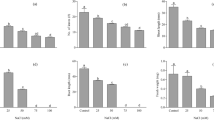Abstract.
The growth (fresh weight), morphogenesis (leaves, roots and shoots) and essential oil composition of mint (Mentha sp. L.) and thyme (Thymus vulgaris L.) plants were determined after 8 weeks under 350, 1,500, 3,000, 10,000 and 30,000 µmol mol–1 CO2. Plants were grown in vitro on basal medium (BM) consisting of Murashige and Skoog salts and 0.8% agar that contained either 0 or 3% sucrose under a 16-h (day)/8-h (night) photoperiod at a light intensity of 180 µmol s–1 m–2 or in soil in a greenhouse under conditions of natural sunlight. Ultra-high CO2 levels (i.e. ≥3,000 µmol mol–1 CO2) substantially increased fresh weights, leaves, shoots and roots for all plants compared to plants grown under ambient air (350 µmol mol–1 CO2) both in vivo and in vitro. For both species, 10,000 µmol mol–1 CO2 was the optimum concentration to obtain the largest growth and morphogenesis responses under in vitro conditions, while the 3,000- to 10,000-µmol mol–1 CO2 range provided the largest yields for soil-grown plants. Essential oil composition (i.e. monoterpenes, piperitonone oxide and limonene from mint and aromatic phenol and thymol from thyme) from the shoot portion of plants grown at all CO2 levels was analyzed in CH2Cl2 extracts via gas chromatography. Higher levels of secondary compounds occurred in vitro when cultures were grown under ultra-high CO2 levels than in ambient air. The concentration of thymol, a major secondary compound in thyme plants grown on BM containing sucrose, was 317-fold higher at 10,000 µmol mol–1 CO2 than in plants grown under ambient air conditions with the same BM. The levels of secondary compound in in-vitro-grown plantlets exposed to ultra-high CO2 concentrations exceeded those occurring in plants grown in the greenhouse under the same CO2 levels. Substantially higher levels of secondary compound occurred in plants under ultra-high CO2 levels on BM containing sucrose than on BM lacking sucrose or in soil. Thymol levels in thyme plants grown on BM containing sucrose were 3.9-fold higher at 10,000 µmol mol–1 CO2 than in shoots grown on BM without sucrose under the same CO2 levels. High positive correlations occurred between thymol concentrations and CO2 levels, fresh weights, shoots, roots and leaves when thyme shoots were grown on BM with sucrose. High positive correlations for thyme shoots grown on BM without sucrose only occurred between thymol concentrations and CO2 levels, fresh weights, shoots and leaves. No positive correlations between thymol concentrations and CO2 levels or any growth or morphogenesis responses occurred for thyme shoots when grown in soil.
Similar content being viewed by others
Author information
Authors and Affiliations
Corresponding author
Additional information
Revision received: 27 September 2000
Electronic Publication
Rights and permissions
About this article
Cite this article
Tisserat, B., Vaughn, S. Essential oils enhanced by ultra-high carbon dioxide levels from Lamiaceae species grown in vitro and in vivo. Plant Cell Reports 20, 361–368 (2001). https://doi.org/10.1007/s002990100327
Received:
Accepted:
Published:
Issue Date:
DOI: https://doi.org/10.1007/s002990100327




